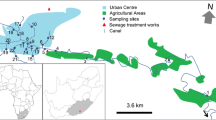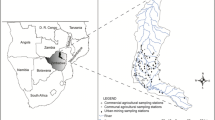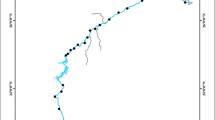Abstract
Benthic diatoms are widely used in Europe to assess ecological status of running waters. The aim of this study was to develop models to predict average pH and total phosphorus (TP) for European stream monitoring using combined diatom data-sets from Hungary and Sweden. As first step, the relationship between the measured environmental variables and the distribution of the taxa was checked by classification by using cluster-analysis and CCA. Diatom data separated clearly along the main hydrogeochemical parameters (e.g. alkalinity, pH). Concerning nutrients, TP was the most determinant factor. Predictive value of the TP model (r = 0.96) is high only for the Hungarian data and the pH model (r = 0.97) can be used in both phycogeographical regions.
Similar content being viewed by others
References
Alefs J, Müller J, Wunsam S (1996) Die Rekonstruktion der epilimnischen Phosphorkonzentrationen im Ammersee seit 1958. GWF Wasser Abwasser 137/8: 443–447.
Almeida SFP, Gil MCP (2001) Ecology of freshwater diatoms from the central region of Portugal. Cryptogamie, Algol. 22: 109–126.
Almer B, Dickson W, Ekström C, Hörnström E, Miller U (1974) Effects of acidification on Swedish lakes. Ambio. 3: 30–36.
Battarbee RW (1984) Diatom analysis and acidification of lakes. Philos. Trans. R. Soc. London, Ser. B 305: 451–477.
Birks H, Line JM, Juggins S, Stevenson AC, Ter Braak CJF (1990) Diatoms and pH reconstruction. Philos. Trans. R. Soc. London, Ser. B 327: 263–278.
Butcher RW (1947) Studies in the ecology of rivers. IV. The algae of organically enriched water. Journal of Ecology 35: 186–191.
Cameron NG, Birks HJB, Jones VJ, Berge F, Catalan J, Flower RJ, Garcia J, Kawecka B, Koining KA, Marchetto A, Sanchez-Castillo P, Schmidt R, Sisko M, Solovieva N, Stefkova E, Toro M (1999) Surface-sediment and epilithic diatom pH calibration sets for remote European mountain lakes with Surface Waters Acidification Programme (SWAP) calibration set. Journal of Paleolimnology 22: 291–317.
Cemagref (1982) Étude des méthodes biologiques d'appreciation quantitative de la qualité des eaux. Rapport Q.E. Lyon. Agence de l'Eau Rhône-Medtierrane Corse.
Coring E (1996) Use of diatoms for monitoring acidification in small mountain rivers in Germany with special emphasis on diatom assemblages type analysis. (DATA). In: Whitton BA, Rott E and Friedrich G (eds.) Use of algae for monitoring rivers. Institut für Botanik, Universität in Innsbruck. pp 7–16.
Cox EJ (1991) What is the basis for using diatoms as monitors of river quality? In: Whitton BA, Rott E and Friedrich G (eds.) Use of algae for monitoring rivers. Institut für Botanik, Universität in Innsbruck. pp 33–40.
Davies TD, Barthelmie RJ, Varley M, Dorling S, Farmer G, Schaug J (1990) European Precipitation Chemistry Atlas (Volume 2): An atlas of monthly and seasonal maps of precipitation amount, non-marine sulphate, nitrate, ammonium, and hydrogen ion concentrations and depositions based on the EMEP Precipitation Chemistry Network: October 1982 to December 1985. University of East Anglia, Norwich and Norwegian Institute for Air Research, Lilleström.
EC Parliament Council (2000) Directive of the European Parliament and of the Council 2000/60/EC establishing a framework for community action in the field of water policy. European Commission PE-CONS 3639/1/100 Rev 1, Luxembourg.
Eloranta P, Andersson K (1998) Diatom indices in water quality monitoring of some South-Finnish rivers. Verh. Int. Verein. Limnol. 26: 1213–1215.
Fölster J, Sandin L, Wallin M (2004) A suggestion to a typology for Swedish inland surface waters according to the EU Water Framework Directive. SLU's report 2004:13.
Hutchinson GE (1967) A Treatise on Limnology. Vol. 2. Introduction to lake biology and the limnoplankton, John Wiley and Sons, New York.
Incédy J (1981) Analitikai laboratóriumi gyakorlat I. [Manual for chemical analyses I.] Veszprémi Egyetem. Veszprém [in Hungarian]. 352 pp.
Incédy J (1996) Analitikai laboratóriumi gyakorlat II. [Manual for chemical analyses II.] Veszprémi Egyetem. Veszprém [in Hungarian]. 289 pp.
Kahlert M, Andrén C (2005) Benthic diatoms as valuable indicators of acidity. Verh. int. Verein. Limnol. 29: 635–639.
Kelly MG, Penny CJ, Whitton BA (1995) Comparative performance of benthic diatom indices used to assess river water quality. Hydrobiologia 302: 179–188.
Kelly MG, Cazaubon A, Coring E, Dell'Uomo A, Ector L, Goldsmith B, Guasch H, Hürlimann J, Jarlman A, Kawecka B, Kwadrans J, Laugaste R, Lindstrøm EA, Leitão M, Marvan P, Padisák J, Pipp E, Prygiel J, Rott E, Sabater S, van Dam H, Vizinet J (1998): Recommendations for the routine sampling of diatoms for water quality assessments in Europe. J. Appl. Phycol. 10: 215–224.
Kolkwitz R, Marsson M (1908) Ökologie der pflanzliche Saprobien. Ber. Deutsche Bot. Gesellsch. 26: 505–5019.
Krammer K (2002) Diatoms of Europe. Diatoms of the European Inland Waters and Comparable Habitats. Vol. 1–4 A.R.G. Gantner Verlag K.G. Ruggel.
Krammer K, Lange-Bertalot H (1991–2000) Bacillariophyceae 1–4. Teil: Naviculaceae. In: Pascher A (ed.) Süsswasserflora von Mitteleuropa. Band 2/1–4. Gustav Fischer Verlag, Heidelberg, Berlin.
Kwandrans J, Eloranta P, Kawecka B, Wojtan K (1999) Use of benthic diatom Communities to evaluate water quality in rivers of southern Poland. In: Prygel J, Whitton BA, Bukowska J (eds) Use of Algae for Monitoring rivers III. Institut für Botanik, Universität in Innsbruck. pp 154–164.
Lampert W, Sommer U (1997) Limnoecology. The ecology of lakes and streams. Oxford University Press. New York, Oxford. 382 pp.
Lange-Bertalot H (1995–2002) Iconographia Diatomologica. Annotated Diatom Micrographs Vol. 1.–9. Koeltz Scientific Books. Königstein, Germany.
Leira M, Sabater M (2005) Diatom assemblages distribution in catalan rivers, NE Spain, in relation to chemical and physiographical factors. Water Res. 39: 73–82.
Marczenko Z (1976) Spectrophotometric determination of elements. Ellis Horwood Ltd. Coll House, Westergate, Chichester, Sussex England and Wydawnictwa Naukowo-Techniczne, Warsaw, Poland. 643 pp.
Németh J (1998) A biológiai vízminsítés módszerei [Methods for biological qualification of surface waters]. Vízi Természet-és Környezetvédelem 7. Környezetgazdálkodási Intézet, Budapest [in Hungarian]. 304 pp.
Newbold JD (1992) Cycles and spirals of nutrients. In: Calow P and Petts GE (eds.) The Rivers Handbook. Hydrological and Ecological Principles. Blackwell Scientific Publications, London, pp 379–408.
Ormerod SJ, Jenkins A (1994) The biological effects of acid episodes. In: Steinberg CW, Wright RF (eds.) Acidification of Freshwater Ecosystems: Implications for the future., Wiley, Chichester. pp 259–272.
Owen RB, Renaut RW, Hover VC, Ashley GM, Muasya AM (2004) Swamps, springs and diatoms: Wetlands of the semi-arid Bogoria-Baringo Rift, Kenya. Hydrobiologia 518: 59–78.
Podani J (2000) Introduction to the exploration of multivariate biological data. Backhuys, Leiden, 407 pp.
Rimet F, Ector L, Cauchie HM, Hoffmann L (2004) Regional distribution of diatom assemblages in headwater streams of Luxembourg. Hydrobiologia 520: 105–117.
Rott E, Pipp E, Pfister P (2003) Diatom methods developed for river quality assessment in Austria and a cross-check against numerical trophical indication methods used in Europe. Algol. Stud. 110: 91–115.
Round FE (1991) Use of diatoms for monitoring rivers. In: Whitton BA, Rott E, Friedrich G (eds.) Use of algae for monitoring rivers I. STUDIA Studentenförderungs-Ges.m.b.H., Innsbruck. pp 25–32.
Sandin L, Sommerhäuser M, Stauber I, Hering D, Johnson RK (2000) Stream assessment methods, stream typology, approaches and outlines of a European stream typology. AQUEM Project (Contract No: EVK1-CT1999-00027), 1st deliverable (31/8/00) 43 pp.
Sandin L, Andersson B, Bergengren J, Bergquist B, Broberg O, Dahlberg M, Fölster J, Jarlman A, Östlund M (2003) Undersökning av påväxt, bottenfauna, makrofyter och fisk längs en naturlighetsgradient i Emåns & Mörrumsåns avrinningsområden Naturvårdsverket Rapport 2003: 4 [in Swedish].
Schmidt R, Wunsam S, Brosch U, Fott J, Lami A, Löffler H, Marchetto A, Müller HW, Prazakov M, Schwaighofer B (1998) Late and post-glacial history of meromictic Längsee (Austria), in respect to climate change and anthropogenic impact. Aquat. Sci. 60: 56–88.
Soininen J, Niemelä P (2002) Inferring phosphorus levels of rivers from benthic diatoms using weighted averaging. Arch. Hydrobiol. 154: 1–18.
Soininen J, Paavola R, Muotka T (2004) Benthic diatom communities in boreal streams: Community structure in relation to environmental and spatial gradients. Ecography 27: 330–342.
Ter Braak CJ, Barendreg LG (1986) Weighted averaging of species indicator values: Its efficiency in environmental calibration. Math. Biosci. 78: 57–72.
Ter Braak CJF, Juggins S (1993) Weighted averaging partial least squares regression (WA PLS): An improved method for reconstructing environmental variables from species assemblages. Hydrobiologia 269/270: 485–502.
Ter Braak CJF, Smilauer P (2002) CANOCO reference manual and CanoDraw for Windows user's guide: Software for canonical community ordination (version 4.5). Biometris, Wageningen and České Budějovice, 500 pp.
Thomas GW, Crutchfield JD (1974) Nitrate-nitrogen and phosphorus contents of streams draining small agricultural watershed in Kentucky. J. Environ. Qual. 3: 46–49.
Van Dam H, Mertens A (1995) Long-term changes of diatoms and chemistry in headwater streams polluted by atmospheric deposition of sulphur and nitrogen compounds. Freshw. Biol. 34: 579–600.
Van Dam H, Mertens A, Sinkeldam J (1994) A coded checklist and ecological indicator values of freshwater diatoms and ecological indicator values of freshwater diatoms from Netherland. Neth. J. Aquat. Ecol. 28: 117–133.
Vilbaste S (2004) Application of diatom indices in the evaluation of the water quality in Estonian streams. Proceedings of the Estonian Academy of Sciences, Biology/Ecology 53: 37–51.
Wetzel R (1983) Limnology, Second edition, Saunders College Publishing, Philadelphia, 858 pp.
Whitton BA, Rott E, Friedrich G (1991) Use of algae for monitoring rivers. – Studia Studentenförderungs-Ges. m.b.H. Innsbruck, 193 pp.
Wilander A (2003) Institutionen för miljöanalys, SLU Boksz 7050 750 07 Uppsala Rapport 2003: 11. Skyddad natur. En undersökning av två sjöar och deras utloppsbäckar i Padjelanta 2002 [in Swedish].
Winter JG, Duthie HC (2000) Epilithic diatoms as indicators os streams total N and total P concentration. J. N. Am. Benthol. Soc. 19: 32–49.
Wunsam S, Schmidt R, Klee R (1995) Cyclotella-taxa (Bacillariophyceae) in lakes of the Alpine region and their relationship to environmental variables. Aquat. Sci. 57: 360–386.
Author information
Authors and Affiliations
Corresponding author
Rights and permissions
About this article
Cite this article
Kovács, C., Kahlert, M. & Padisák, J. Benthic Diatom Communities Along pH and TP Gradients in Hungarian and Swedish Streams. J Appl Phycol 18, 105–117 (2006). https://doi.org/10.1007/s10811-006-9080-4
Received:
Accepted:
Published:
Issue Date:
DOI: https://doi.org/10.1007/s10811-006-9080-4




